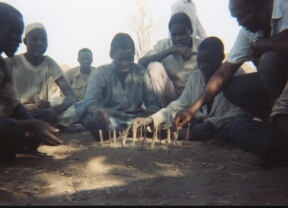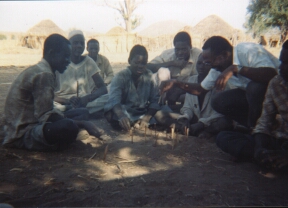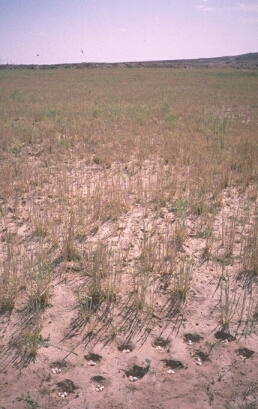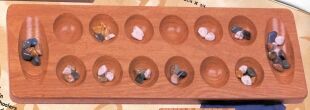
Rules for Chadian Games

The boys’ favourite game (besides teasing the girls) is soccer, usually with a ball made of old worn out clothes knotted together. The girls’ favourite game is hopscotch, much like how it is played in the North America, except that you try to pick up a round stone between your toes in the first square and skip with it still held between their toes.
<=== Player B===<<
|
B |
12 | 11 | 10 | 9 | 8 | 7 |
A |
| 1 | 2 | 3 | 4 | 5 | 6 |
>>=== Player A ===>
This game is played with a game board designed as above, or by digging six small holes in a row, then six more holes beside them. These twelve holes are known as the "houses". To the left and to the right of these holes are two larger holes, also known as the "Mancala" (Bankers) or "home bins". The Mancala to your right is yours, as are the six pockets in front of you. Your Mancala and six pockets are known as your "territory." Player A has small bins 1 - 6 in front of him and the large home bin to his right. Player B has bins 7 - 12 in front of him, and the bin to his right.
Standard Version: The object of the game is to collect
as many game pieces (stones or seeds, known as the "warriors")
as possible by the end of the game.
To start
the game, place four game pieces in all twelve of the smaller pockets,
or "houses". One player starts the game by removing
the stones from any of their own pockets and placing one in each
pocket, starting with the next pocket to the right and continuing
counter-clockwise. Once you touch a group of stones, you must play
them. You cannot put them back. Include your Mancala as a space as
you place the stones in the pockets. If there are enough stones
to go past your Mancala, continue placing them into your opponent's
pockets. However, skip over your opponent's Mancala when placing
stones.
If the last stone you play lands in
your Mancala, then you get another turn! If it lands in an empty
pocket on your side of the board, then you get to take that stone, as
well as the stones from your opponent's bin directly across from that
pocket, and place them all
in your own Mancala.
The game ends when either player's
"houses" are all empty. The other player then places all
stones still on their side of the board into their home bin. The player with the most stones in their
Mancala wins
the game!
Alternate Versions of the game:
| The game can be played with three, four, five or eight stones in each of the twelve houses. A beginner's version of this game is played with three stones in each "house". | |
| This game is traditionally played in sets, or rounds. The ultimate object of a player is to win the set. A player wins the set if they win five games more than his opponent does, or if they succeed in winning four games in succession. |
Links to Mancala:
| The history of Mancala | |||||||
| How to make your own Mancala board game | |||||||
Play Mancala...
| |||||||
| Mancala Club |

This game is never supposed
to be played during the rainy season, or else, according to tradition,
you could get struck by lightning. This is probably a way to
discourage children and adults from playing this game when they should
be sowing or reaping their fields. Thus, the game is usually
played between January to May.
In each region of the country, this game goes
by the local name for "war", be it in the Ngambay, Maba,
Sokoro or some other Chadian language. This is a game usually
played by young and old men, but women will also play it together, but
much less violently than the men. Often in the villages, the
participants (two opposing players or groups) will get so involved in
the game that they will insult one another as they move their sticks
across the board, or will play standing up, shoving the sticks into
the ground. and often, the game will end in a brawl.
First you find a place where there is at
least one inch thick of sand, and make a board of 25 squares (5 long
by 5 wide). You also need 20 sticks, 10 being of a different colour
of wood. The board is prepared by cupping the index finger, and
running it across the sand in a line of five mini squares, five times
next to each other, about 1 inch square each. You then go
horizontally from the original direction, to make the squares a little
clearer.
The first player "sets up his
weapon." Each way of setting up his sticks to begin has a
name, known by all or given by the player using it. Here are two
examples of set-ups:
|
|
|
|
2 |
|
|
|
|
|
2 |
|
|
|
|
|
2 |
|
|
|
|
|
2 |
|
|
|
|
|
2 |
|
"Le fusil" (the gun)
| 2 | ||||
| 2 | 2 | |||
| 2 | ||||
| 2 | ||||
"La lance" (the spear-head)
Here are the rules for moving:
| Only one stick can be moved at a time. | |
| The sticks can be moved only horizontally, not diagonally. | |
| Three single sticks in a row (not four or five) is called a "gunshot". | |
| For each player's gunshot, he can take one single stick from his opponent off the board. It cannot come from a square where there are two sticks; only from a square with one stick in it. | |
| It is possible to move a stick back and forth between rows of two single sticks, creating a "machine gun effect" where at each move, the opponent loses a stick. This can be represented by a "haut les mains" (stick 'em up/hands up), where the player places his stick flat in the two boxes he can travel between, killing his opponent each time. See the example below: |
|
1 |
1 | 1 | ||
|
1 |
1 | 1 | ||
|
== |
== |
== |
== |
|
| 1 | ||||
| 1 |
Two forms of "haut les mains"
| A match doesn't always have to end with a "haut les mains." It ends when the opponent is rendered powerless. The match isn't played to the end, but until one player has knocked the other player into a position where he cannot possibly put three single sticks in a row. | |
| The winner of a match gains a point, and gets to go first in the next match. The person at the end (i.e. when the players are tired) who has the most points is the winner. |

We welcome the rules to other Chadian games. Please write us to let us know all about them!
Write us!


